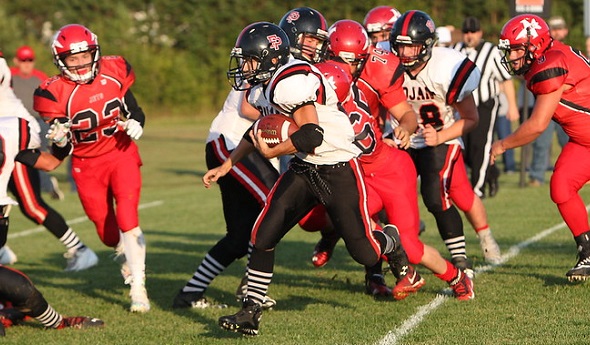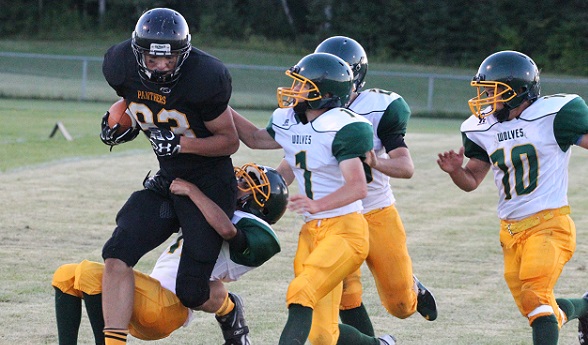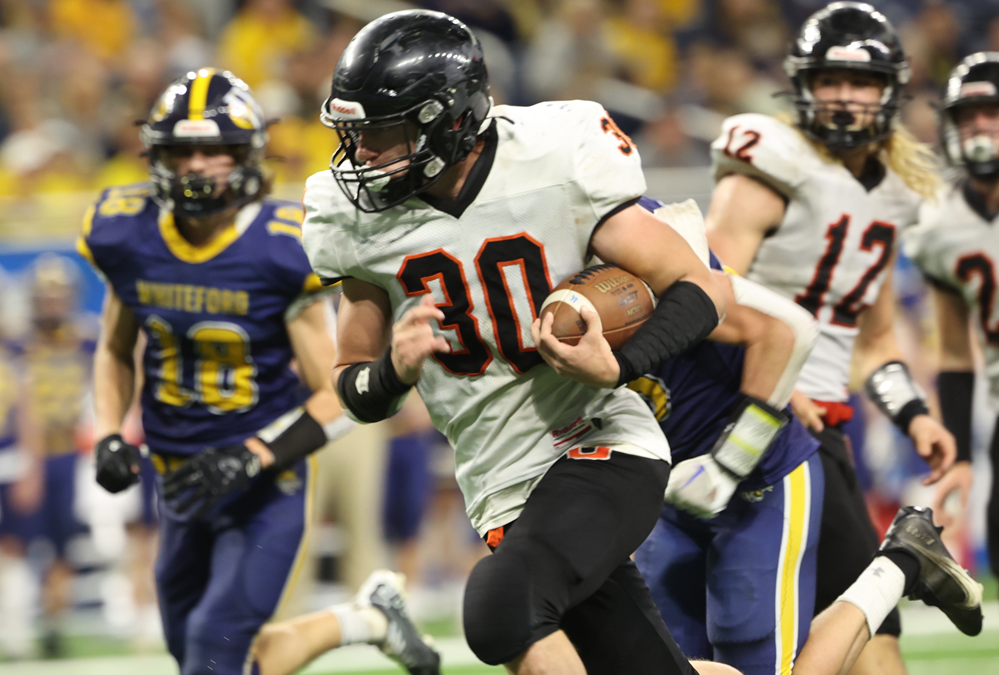
8-Player Takes Flight in Upper Peninsula
September 28, 2017
By Dennis Grall
Special for Second Half
ESCANABA – Three yards and a cloud of dust. That was the highly successful version of football applied by veteran Ohio State coach Woody Hayes as big bruisers dominated the game.
 It certainly is not the preferred style on the fields of 8-player football. Nope, this version is much more open-field and definitely more exciting, full of big plays and a ton of scoring.
It certainly is not the preferred style on the fields of 8-player football. Nope, this version is much more open-field and definitely more exciting, full of big plays and a ton of scoring.
Take Powers North Central as the prime example. The Jets have won the last two 8-player MHSAA championships with back-to-back 13-0 seasons, piling up yards and points in their first two seasons in the 8-player game with a large group of skilled athletes.
Their winning streak ended at 27 games earlier this season, but the style they displayed with exceptional athleticism led by Jason Whitens and Bobby Kleiman has caught on with many other programs.
The Upper Peninsula, at the forefront of the 8-player game due largely to decreasing enrollments, has been lighting up the scoreboards this year. Teams like Pickford and Cedarville, Rapid River and Stephenson, Ontonagon and Crystal Falls Forest Park are progressing with the same formula as North Central by featuring explosive offenses.
Citing some 8-player detractors who don't think the game is real football, veteran Cedarville coach Scott Barr said, "I don't think anyone can argue that it (8-player) has not been healthy for football. It has been healthy."
The game is thriving in small schools because the 8-player version simply has allowed football to remain in the athletic program despite shrinking enrollments across the state.
"It has allowed us to keep football," said veteran coach Steve Ostrenga of Rapid River, who led the Rockets into 8-player Finals in 2011 and 2013 and into the playoffs every season since making the switch after going 1-7 in 11-player in 2010.
"We did it out of necessity. We may have waited too long," added Ostrenga, recalling that last year of 11-player football when only one sub was available at several games.
Veteran Pickford skipper Josh Rader has an idea why the 8-player game has met approval at so many small schools. "It is a high-octane game. It is a lot of fun to watch," he said. "It puts a lot of pressure on defenses because it is such a wide open game. It makes it exciting for the fans."
No longer do fans have to squint and squirm in their seats to see what is happening among the goliaths in the line. Now the football is visible in the wide open spaces as skilled athletes display dazzling moves, whether the team favors the extremely popular spread offense or uses the more familiar run-oriented approach.
 "It is more a one-on-one oriented game now," said coach Ben Mayer of Ontonagon, whose program has consolidated with neighboring Ewen-Trout Creek, which yearly battled small player turnouts just to keep the game alive. Fifteen E-TC students are playing football at Ontonagon, with six on the varsity, highlighted by 6-foot-7 receiver Jacob Witt, who caught MHSAA 8-player record 24 touchdown passes last season.
"It is more a one-on-one oriented game now," said coach Ben Mayer of Ontonagon, whose program has consolidated with neighboring Ewen-Trout Creek, which yearly battled small player turnouts just to keep the game alive. Fifteen E-TC students are playing football at Ontonagon, with six on the varsity, highlighted by 6-foot-7 receiver Jacob Witt, who caught MHSAA 8-player record 24 touchdown passes last season.
"Without 8-player, we would have gone under a while back," said Mayer, who played for U.P. Sports Hall of Fame coach Bob "Cubby" Carlson at Ontonagon. He said the Gladiators were forced to use four freshmen and had 130-pound athletes on the line in past years.
"Football has changed a lot in the last four years," he said of the time since the Gladiators moved to the 8-player game. "The ball is in the air. It is fun to watch.”
Mayer said 8-player also enables his program to offer junior varsity football to younger students, instead of having them compete against older, bigger and stronger players with the potential to increase injuries.
"There is not as much violence between the tight ends now because we don't play in those tight spaces," said Mayer.
He also recalls putting "wildly undersized kids in the line against bigger schools with monsters from legitimate programs, with kids getting stepped on and squashed on.
"You do have a lot of choices in 8-man. I can put smaller kids somewhere and they will be all right, and we can still play football."
Ostrenga said it seems injuries, especially of the serious variety, have also seemed to decrease. "We used to hit a lot more in practice. Now we do a lot of teaching and drill work and conditioning," he said, adding MHSAA officials have been in the forefront of trying to reduce injuries with new regulations.
Ostrenga said in the 11-player version, many times it came down to "men playing against boys."
He did say, however, that under the 8-player game coaches "can tend to overuse a player. You get a really good athlete and use him as a crutch in a game."
Ostrenga said it took time to support the change to 8-player football. "I was against 8-man football at first. Now it has made me more open-minded and allowed me to become more understanding." He said 8-player athletes need to have speed, strength, balance and shiftiness.
"Some big guys can't move that well," he said, indicating this version of football requires more agile and nimble athletes to cover the wide-open spaces. "The big thing is understanding you have to get your athletes on the field. You just have eight guys on the field and you are (more) exposed. In 11-man you can hide someone. In 8-man, coaches will find your weaknesses."
Rader agreed, noting, "It puts a lot of pressure on the defense because the game is so wide open. There is a little different strategy. It is a disadvantage for the defense because (the field) is so wide open and there is not a lot of help. You want to take the advantage your offense has over the defense in one-on-ones.
"We like to run the ball and throw the ball, so our athletes can utilize the open field.”
Barr said 8-player quarterbacks are more difficult to contain than typical pocket passers. "They are more elusive," he said, recalling how the 6-foot-4 Whitens could take the direct snap, survey the field and decide whether to throw or run the ball himself.
In the 2016 MHSAA title game, Whitens ran 17 times for a record 352 yards and six touchdowns as the Jets beat Deckerville 58-22. The Jets ran for 469 yards that night.
"You rarely see teams ground and pound," Barr said of the8-man game, noting he began to rely on the spread offense in 11-player football as he tried to figure out how to match up with the over-powering tailback-oriented rushing attack of perennial power Forest Park, which began playing 8-player football in 2016.
Barr said the kicking game is of vital importance now and that secondary tackling is a tough transition because of the explosive offense athletes.
He said "the hybrid player who has size and speed" is featured in 8-player "and it can eliminate the real big kids," which he said are seldom a factor for small schools anyway.
Another plus for the 8-player game comes in scheduling, where Class D schools no longer have to face larger Class C programs and can also find opponents in northern Wisconsin, which also has declining enrollments.
Bark River-Harris and Lake Linden-Hubbell are the only Class D schools still fielding 11-player football teams in the Upper Peninsula. Three other schools, Class D Wakefield-Marenisco and Bessemer and Class C Ironwood have formed a cooperative program, Gogebic Miners, for football purposes.
 Denny Grall retired in 2012 after 39 years at the Escanaba Daily Press and four at the Green Bay Press-Gazette, plus 15 months for WLST radio in Escanaba; he served as the Daily Press sports editor from 1970-80 and again from 1984-2012. Grall was inducted into the Upper Peninsula Sports Hall of Fame in 2002 and serves as its executive secretary. E-mail him at [email protected] with story ideas for the Upper Peninsula.
Denny Grall retired in 2012 after 39 years at the Escanaba Daily Press and four at the Green Bay Press-Gazette, plus 15 months for WLST radio in Escanaba; he served as the Daily Press sports editor from 1970-80 and again from 1984-2012. Grall was inducted into the Upper Peninsula Sports Hall of Fame in 2002 and serves as its executive secretary. E-mail him at [email protected] with story ideas for the Upper Peninsula.
PHOTOS: (Top) Crystal Falls Forest Park downed Powers North Central 66-58 in Week 2 as the teams combined to score more than 100 points for the third time in two seasons. (Middle) Ewen-Trout Creek’s Jacob Witt, here against Carney-Nadeau last season, caught 24 touchdown passes in 2016 and is playing as part of a co-op team with Ontonagon this fall. (Photos by Paul Gerard.)

Ubly Offense, Kicker Pile Up Record Book Listings During Championship Run
By
Geoff Kimmerly
MHSAA.com senior editor
April 12, 2024
Ubly finished a combined 27-1 over the last two seasons, following up a Division 8 runner-up run in 2022 with its first MHSAA Finals championship this past November. And the Bearcats stacked plenty of record book performances along the way.
Individually, senior Brett Mueller made the single-season extra point list again this past season with 76 in 81 tries, and he set the MHSAA career record with 220 extra points over 232 attempts, 40 games and three seasons. He has signed with Saginaw Valley State.
As a team, Ubly was added to the record book 13 times for achievements over the last two years, most notably in the rushing game. The Bearcats topped 5,200 total yards both seasons, and also made the rush yardage list twice including with a sixth-best 5,148 in 2022. Their 90 touchdowns in 2022 rank seventh all-time, and their 85 this past fall tied for 13th, and they tied the record with 10 rushing touchdowns in a 2022 win over Reese and set another record with 84 rushing touchdowns total that season.
See below for more recent record book additions in 11-player football, and click the heading to see the record book in full:
11-Player Football
Dundee’s Ben Miller has a pair of basketball record book entries, and he’s also been added in football for scoring seven touchdowns in his team’s 72-36 win over Erie Mason on Oct. 20, 2017. A senior that season, he ran for five scores and caught two touchdowns passes.
Nearly four decades later, Howard City Tri County’s Mike Wagoner has reached the record book for his work on defense in 1985. A junior that season, Wagoner returned three interceptions for touchdowns – 65, 55 and 35 yards – which would have been second on the list at the time and remains tied for third-most for one season.
Jaxon Lippert tops the list of 21 who have returned kickoffs 99 yards. Lippert, now a senior at Walled Lake Western, joined the list against Davison during his junior season.
A handful of records from Warren De La Salle Collegiate’s recent run of Ford Field teams and also one from decades ago were added. Jake Badalamenti was added three times for kickoff returns between 96-99 yards, one as a junior in 2016 and two as a senior the following fall, and Marty Wyzlic was added for his 95-yarder in 1976. Mason Muragin is the new leader for tackles for loss in a career with 71 over three seasons, and he also was added to the single-season list with 31 as a junior in 2021, as was Will Beasley for 38 as a junior in 2020. Wayne Wright was added for his 16 sacks over nine games as a senior in 1984, and Josh Cox was added for his 100-yard interception return as a senior in 2012. Muragin plays at Illinois, Beesley plays at Princeton, Cox played at Central Michigan, and Badalamenti played baseball at Wayne State.
Pinckney junior Nolan Carruthers caught 16 passes during a 13-7 loss to Jackson on Sept. 15, good to tie for ninth-most in one game and breaking the Livingston County record of 14 by Hartland’s Greg Matthyssen in 2007 – a listing that also was added.
Ethan Wissner did some major lifting, or rather carrying, during Elkton-Pigeon-Bay Port Laker’s 28-14 District Final win over Montrose in 2022. The then-senior ran 42 times to make the record book, for 289 yards and three touchdowns. He’s continuing at Siena Heights.
Senior quarterback Andrew Schuster and junior receiver DeShaun Lanier formed a game-changing pass-catch combo this past season for Clinton Township Chippewa Valley, with Schuster finishing his career with nine record book listings and Lanier totaling six with a season to play. Schuster most notably was added for 212 completions on 301 attempts for 2,766 yards and 28 touchdowns this season, and 321 completions and 4,199 career yards over two years and 22 games. Lanier was added in part for 73 receptions for 1,132 yards and 15 TDs this fall. Junior kicker Juliano Haddad also earned impressive mentions with 10 field goals and 50 extra points – and he’ll carry a streak of 35 straight extra points into next fall. Schuster has committed to Grand Valley State.
Fulton’s Evan Barton has been added to the single-game touchdowns list after catching four scoring passes Sept. 8, 2017, against Potterville. He was a senior that season.
Saginaw Heritage’s Braylon Isom completed his career this past fall as arguably the most accomplished receiver in MHSAA history. His name is listed in the record book eight times, with career records of 3,837 receiving yards and 52 touchdowns over 34 games and four seasons, and with a single-season record 26 touchdowns this past fall over 12 games. His 91 career receptions rank fifth, and he’s also listed for 82 catches and 1,617 yards (seventh-most) as a senior and 1,428 yards and 18 touchdowns as a junior. He will continue at Miami (Ohio).
Evart’s 24-8 run over the last three seasons has been its most successful of the MHSAA playoff era, and senior quarterback Preston Wallace has played an enormous part. He finished his 33-game career in the fall – he came up for one game as a freshman – on record book lists twice for single-season passing yards and touchdowns and on career lists for 662 attempts, 421 completions, 6,955 yards and 88 passing touchdowns over those 32 games and three seasons. The yardage ranks 15th all-time, and the touchdowns are tied for sixth-most for one career.
The 2005 Midland Bullock Creek team was added for scoring 547 points over 12 games. The Lancers finished 11-1, their only loss in a Division 5 Regional Final.
PHOTO Ubly's Seth Maurer (30) carries the ball during the Division 8 championship win over Ottawa Lake Whiteford in November.

